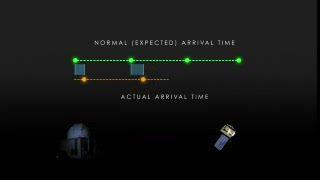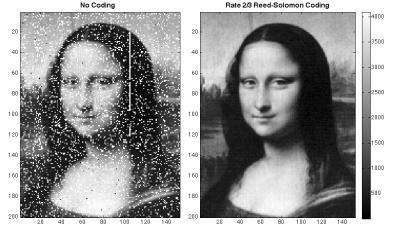Precise timing was the key to transmitting the image. Sun and colleagues divided the Mona Lisa image into an array of 152 pixels by 200 pixels. Every pixel was converted into a shade of gray, represented by a number between zero and 4,095. Each pixel was transmitted by a laser pulse, with the pulse being fired in one of 4,096 possible time slots during a brief time window allotted for laser tracking. The complete image was transmitted at a data rate of about 300 bits per second.
The laser pulses were received by LRO's LOLA instrument, which reconstructed the image based on the arrival times of the laser pulses from Earth. This was accomplished without interfering with LOLA's primary task of mapping the moon's elevation and terrain and NGSLR's primary task of tracking LRO.
The success of the laser transmission was verified by returning the image to Earth using the spacecraft's radio telemetry system.
Turbulence in Earth's atmosphere introduced transmission errors even when the sky was clear. To overcome these effects, Sun and colleagues employed Reed-Solomon coding, which is the same type of error-correction code commonly used in CDs and DVDs. The experiments also provided statistics on the signal fluctuations due to Earth's atmosphere.
"This pathfinding achievement sets the stage for the Lunar Laser Communications Demonstration (LLCD), a high data rate laser-communication demonstrations that will be a central feature of NASA's next moon mission, the Lunar Atmosphere and Dust Environment Explorer (LADEE)," says Goddard's Richard Vondrak, the LRO deputy project scientist.
The next step after LLCD is the Laser Communications Relay Demonstration (LCRD), NASA's first long-duration optical communications mission. LCRD will help develop concepts and deliver technologies applicable to near-Earth and deep-space communication.

NASA Goddard scientists transmitted an image of the Mona Lisa from Earth to the Lunar Reconnaissance Orbiter at the moon by piggybacking on laser pulses that routinely track the spacecraft.
HD and other formats: http://svs.gsfc.nasa.gov/vis/a010000/a011100/a011137/index.html
(Photo Credit: : NASA's Goddard Space Flight Center)

To clean up transmission errors introduced by Earth's atmosphere (left), Goddard scientists applied Reed-Solomon error correction (right), which is commonly used in CDs and DVDs. Typical errors include missing pixels (white) and false signals (black). The white stripe indicates a brief period when transmission was paused.
(Photo Credit: Image courtesy: Xiaoli Sun, NASA Goddard)
Source: NASA/Goddard Space Flight Center